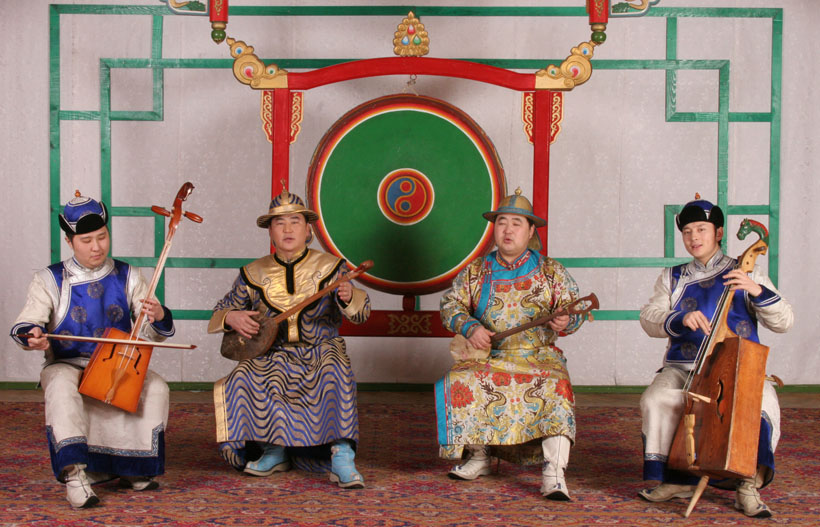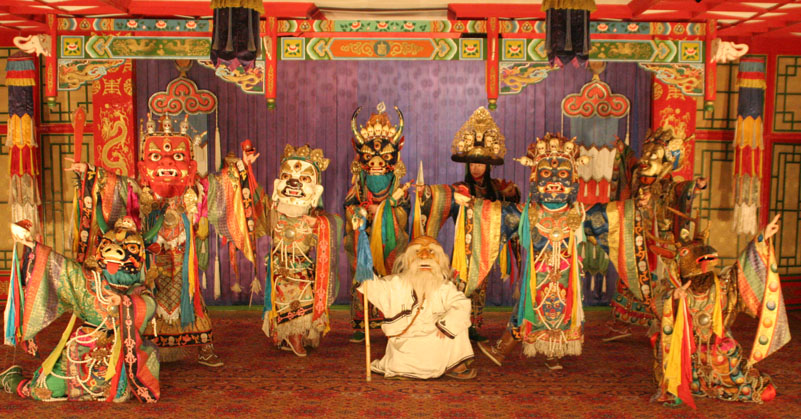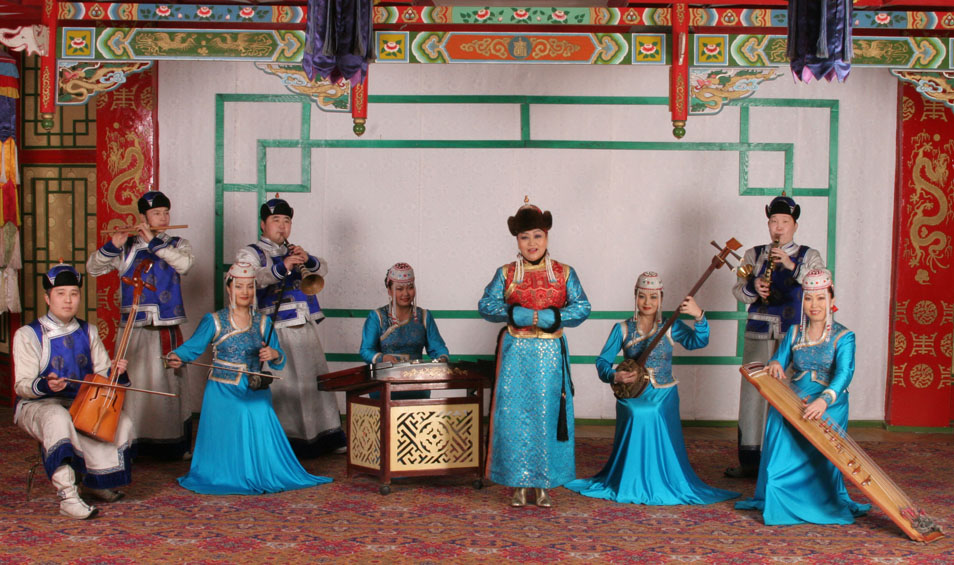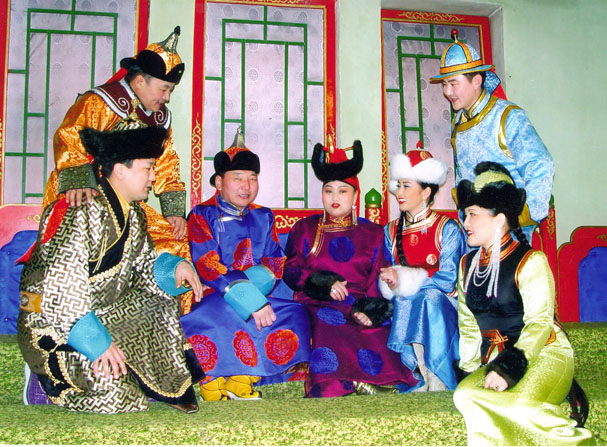The old silk road skirted the cold Gobi desert (known as a cold desert due to its annual temperatures and altitudes); dinosaur eggs were discovered in the early 1920s and numerous dinosaur fossils have been found throughout the area and still continue today.
Our trip started in Ulaanbaatar, or more commonly referred to as UB. We hired the same tour company we've used before, Montrail Tours (click on the link to go to their website) and set out on a 5-day adventure. The weather was in the 50s - 70s, comfortable for late August. We were able to meet up with a couple of friends visiting Mongolia as our trips mirrored each others and we met them periodically along the way.
Driving south...
Day 1 our destination was about 420 kms (~260 miles) outside of UB to a place called Tsagaan Suvraga or White Shrines. From a distance, the cliffs look like shrines and city structures, thus the name of this beautiful area. These colorful cliffs used to be sea bottom millions of years ago.
A walk through the area gave us the feel of being in Bryce Canyon or southern Utah.
Our driver Damia took us to an underground cave in the area. We went in about 80 yards or so until we could stand no more...
We stayed in the Tsagaan Suvraga ger camp and enjoyed a delicious dinner cooked by the camp staff and then spent a lovely evening under one of THEE most densely star filled skies we have ever seen. They say that the stars visible out on the steppes of Mongolia are some of the brightest and densest visible to the naked eye. We have to agree, as neither of us have ever seen a sky so clear or so solidly filled with so many stars and with the Milky Way so 'milky'. One of the most beautiful sights which our camera could not capture...you'll just have to imagine its beauty.
Day 2 we drove towards South Gobi and the Yolyn Am gorge in the Gobi National Park.
This is a herders winter home...locked up as this is summer...
| Gobi highway...you can almost drive where you want...amazing |
We stopped at a small museum dedicated to educating locals and visitors alike, of the wildlife and natural environment of the area. Protection of this area started back in the 1960s. Their exhibits of taxidermy animals of the area was impressive, though the quality was rough (sorry, no photos).
The drive through the seemingly volcanic rocky cliffs of the Gurvan Saikhan Mountains (also known as the Three Beauties) to the end of the road where the gorge can only be visited on foot or horseback was slow, twisty, rocky and narrow. The gorge gets its name from the old world vultures which inhabit the area. The depth and height of the gorge shades and protects it from snow melt and one can often see ice and snow even in the middle of summer. This year we were not so lucky. The hike to/from the gorge was picturesque and cool and took maybe 45 minutes each way.
A Mongol on horseback--they really do start young
On our way back from the gorge, driving back through the mountains, we spotted 2 lone Alpine Ibex, a wild goat species native to this area.
Our camp that night was one of thee best ger camps we visited. The staff were so friendly and welcomed us with local music and donning local costumes welcoming travelers from afar. We were greeted with a a bowl of aaruul (sour milk curds) while soft Mongolian music played in the background. Aaruul is an acquired taste, to say the least.
Looks like they gave us the wedding suite!
Dining Hall which served a variety of delicious food
Upon our departure, our vehicles were blessed with the sprinkling of milk on the tires, bringing luck to those inside, a true Mongolian tradition of blessings and offerings.
Day 3 we drove to the most beautiful sand dunes of the desert, the Hongor Sand Dunes also known in local language as 'Khongoriin Els' the sandiest area of the Gobi encompassing an area of ~350 sq miles. The dunes are 180 kms (~110 mi) long x 27 kms (~17 mi) wide and rise up 100-300 meters (300-900 ft) high. The winds are forever present and the lovely sounds the winds make blowing across the sand have locals referring to the dunes as 'the singing dunes'.
Early in the day we started with a camel ride on one of the Bactrian double humped camels. Not a way we'd want to see the world, but okay for an hour or so.

Late afternoon took us climbing up the 300 meter dune to the top where spectacular views awaited. WHAT A HIKE! For every foot up, you sink back down 6". One of the guides we met at the top said average time for people to get to the top is 1 hour...it took us 40 minutes--we felt pretty good.
Beyond the dunes, the steppe extends as far as the eye can see.
Some of the Russian vehicles commonly used by tour companies. We had a Ford Explorer, others aren't so lucky with these old Russian vans, or MIGs as Buddy refers to them. We've heard their comfort level is a 1 on a scale of 1-10.
An eve at camp
Day 4 our last day in the Gobi took us from the dunes to the sandstone cliffs, more famously know as the Flaming Cliffs, or Bayanzag to the locals. This area of the Gobi is shrouded in a red dirt which makes for spectacular sun rises and sun sets. An American paleontologist, Roy Andrews, made this area famous, with his documented discoveries of dinosaur eggs in the 1920s. The cliffs rise from nowhere and reminded us so much of southern Utah, another place not to miss on this beautiful planet of ours.
Our camp
Buddy met all the staff and even had a game of hoops with a very good little player.
Gobi wildlife...
From our camp you would never suspect the flaming cliffs are just over yonder.
Just over the ridge from the cliffs...amazing topography...
From the white shrine to the iced gorge, to the highest sand dune, to the red cliffs, all so brilliantly stunning. We were able to get in daily hikes and found ourselves easily imagining the area as it was back in the days of dinosaur egg discoveries. Today the Gobi is one of the least populated places on earth with only 3 inhabitants for every sq mile, so our imaginations were able to run as free as the camels, horses and ibex.
Day 5 we left one of driest places on early--Gobi literally means 'waterless place' and headed back to the city, which, by the way, isn't that much more fertile. We arrived back in the city after roughly 10 hours of driving.
The evening after our return we were treated to a local folk song and dance ensemble within walking distance of our apartment called Tumen Ekh. Photos are not allowed inside, but we were able to find a few on line to share with you of bits of the hour-long production with elaborate costumes, traditional musical instruments, masks, contortionists, singers and musicians.






Anyone up for a visit?
